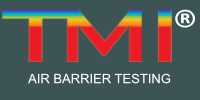Whole Building Airtightness Testing C402.5 Air Leakage Test
USACE Air Leakage Test Protocol ASTM E 779
BUILDING ENCLOSURE AIRTIGHTNESS TESTING
Once a building enclosure is complete, how do you make sure the envelope is meeting performance requirements?
The simplest way to find out is by conducting a building enclosure airtightness test in order to quantify its air leakage and qualitatively identify the airflow paths through the air barrier system. This method determines how much energy could be lost via loss of continuity in the air barrier.
A building enclosure airtightness test, or an air leakage test, is conducted using orifice blower door fans that induce a series of positive and negative pressures on the building envelope. The Architect of Record (AOR) will specify the purpose of the test, the two most common test purposes are: architectural or air barrier systems enclosure test (HVAC related openings excluded) or architectural plus HVAC operational building enclosure test (HVAC related openings included). Testing methods for quantitative building enclosure airtightness testing include: multipoint regression (ASTM E779), repeated single point (ASTM E1827) or two-point airtightness testing (ASTM E1827) large or multizone buildings (ASTM E3158). Data from testing is used to quantify the rate and magnitude of air leakage through the building envelope. To pass an air leakage test, a building must be below the allowable rate or magnitude of air leakage required by project specifications. Mock-up or preliminary testing can predict success or show weaknesses in the air barrier system so corrections can be made before air barrier connections are covered in the construction process. Final testing must only be conducted once the building envelope or air barrier has been fully installed.
TMI® specializes in conducting enclosure airtightness testing on large buildings. Our technicians regularly conduct pressure testing on large complex United States Army Corps of Engineers (USACE) and Naval Facilities Engineering Command (NAVFAC) projects, and are well versed in common test standards and procedures.
Most standards require the commissioning authority to be an independent third-party, identified by the owner.
Who Requires Building Enclosure Airtightness Compliance Testing?
Air leakage testing is a valuable part of the building enclosure commissioning process. The USACE Air Leakage Test Protocol for Building Envelope, requires pressure testing an air barrier system for airtightness. In addition, the Air Leakage Test protocol is also used on NAVFAC, Air Force Civil Engineer Center (AFCEC), and The National Aeronautics and Space Administration (NASA) construction projects. Testing specified in the project documents may be required to be performed as an Architectural Test and/or an Architectural Test plus HVAC.
Public Buildings Service (PBS) P-100 of the General Services Administration (GSA)– 2017 requires Enclosure Airtightness Testing of the building envelope of GSA public buildings. The PBS Facilities Standards airtightness targets for 2017 and beyond have been specified as:
Baseline: Maximum air leakage rate .0.40cfm/ft2 at 75 Pa
According to ASTM E779 or ASTM 1827, this is in line with the requirements of ASHRAE 189.1.2014.
Tier 1 High Performance: Maximum air leakage rate 0.25cfm/ft2 at 75 Pa
Tier 2 High Performance: Maximum air leakage rate 0.15cfm/ft2 at 75 Pa
Tier 3 High Performance: Maximum air leakage rate 0.10cfm/ft2 at 75 Pa
According to ASTM E779, ASTM E1827 and USACE Air Leakage Test Protocol for Building Envelopes (version 2)
The 2021 International Energy Conservation Code (IECC) section C402.5 provides for building thermal envelope testing in accordance with ASTM E 779, ASTM E1827, ASTM E3158 or ANSI/RESNET/ICC380. The whole building air leakage rate is not to exceed 0.40cfm/ft2 at 75 Pa. Alternative methods are allowed for Class R and Class I, along with dwelling and sleeping units.
To Learn More About Airtightness Testing, USACE Air Leakage Testing, GSA PBS (P100) please visit the following links:
Whole Building Airtightness Testing and USACE Air Leakage Test Protocol for Building Envelope
General Services Administration PBS (P100)
Test Standard and Description
ASTM E 779
Determining Air Leakage Rate by Fan Pressurization
U.S. Army Corps of Engineers Air Leakage Test Protocol for Building Envelopes—Version 3
ASTM E 3158
Measuring the Air Leakage Rate of a Large or Multizone Building.
ASTM E 1827
Determining Airtightness of Buildings Using an Orifice Blower Door
ASTM E 2813
Building Enclosure Commissioning
ASTM E 1554
Determining Air Leakage of Air Distribution Systems by Fan Pressurization
ASTM E 1186
Air Leakage Site Detection in Building Envelopes and Air Barrier Systems
“U.S. Army Corps of Engineers Air Leakage Test Protocol for Building Envelopes.” U.S. Army Corps of Engineers Air Leakage Test Protocol for Building Envelopes Version 3 – May 11, 2012 (n.d.): n. pag. 11 May 2012. Web. 16 Oct. 2015
Facilities Standards for the Public Buildings Service. General Services Administration. N.p., Mar. 2015. Web. 16
